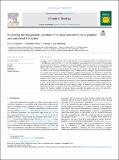Evaluating the biosignature potential of nitrogen concentrations in graphite and associated K-silicates
Abstract
The oldest remnants of life on Earth from various localities in the Isua supracrustal belt in Greenland date back to >3.7 billion years ago (Ga). They are in the form of graphite, whose biogenicity is controversial. Previous studies used the presence and isotopic composition of nitrogen in graphite from along the Isua belt to argue both for and against biogenicity. To determine if the nitrogen chemistry of graphite can indeed serve as a biosignature, we investigated a hydrothermal graphite deposit from south-east Greenland (1.87–1.82 Ga). We found indications that molar C/N ratios of hydrothermal graphite may be similar to those of biogenic graphite from the Archean rock record, meaning that the nitrogen content of graphite is itself perhaps not diagnostic of ancient life, requiring caution in future studies. However, the hydrothermal graphite deposit also revealed unusually low N concentrations in associated silicates, despite a wide range of K concentrations up to 5 wt%. Using a thermodynamic model of nitrogen speciation in the presence of graphite, paired with previously published partition coefficients for ammonium in K-silicates, we show that abiotic process can explain these low N-concentrations of around 1 μg/g in potassic silicates. Higher concentrations of >10 μg/g, such as those found in graphitic metapelites from the Isua supcracrustal belt, would, however, require an unusually N-rich fluid. Such a N-rich fluid is most easily derived from the breakdown of biomass within sediments prior to graphitization. We therefore conclude that potassic silicates associated with graphite can serve as an indirect biosignature. Our approach supports previous inferences of life on Earth back to at least 3.7 Ga.
Citation
Stueeken , E E , Szilas , K & van Hinsberg , V J 2023 , ' Evaluating the biosignature potential of nitrogen concentrations in graphite and associated K-silicates ' , Chemical Geology , vol. 617 , 121274 . https://doi.org/10.1016/j.chemgeo.2022.121274
Publication
Chemical Geology
Status
Peer reviewed
ISSN
0009-2541Type
Journal article
Description
Funding: This study was financially supported by a NERC Frontiers grant (NE/V010824/1) to EES and an Osisko research stipend to VvH.Collections
Items in the St Andrews Research Repository are protected by copyright, with all rights reserved, unless otherwise indicated.

